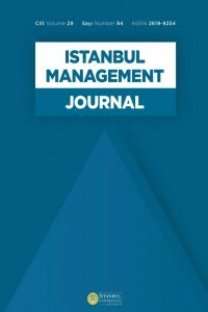THE MEDIATING ROLE OF TRUST TOWARDS E-WOM ON THE RELATIONSHIP BETWEEN BIG FIVE PERSONALITY CHARACTERISTICS AND INFLUENCE BY E-WOM
Bu çalışmanın amacı, büyük beş kişilik özellikleri olan dışadönüklük, duygusal denge, uyumluluk, özdisiplin, yeniliğe açıklığın e-WOM’a duyulan güven üzerinden e-WOM’dan etkilenmeye nasıl etki ettiğini incelemektir; böylece e-WOM alanında yapılan çalışmalarda ihmal edilen bireysel farklılıklar konusu ele alınmış olacaktır. Sonuçlar göstermektedir ki; uyumluluk ve özdisiplin kişilik özellikleri ile eWOM’dan etkilenme arasındaki ilişkilerde, eWOM’a güven tam aracılık rolü üstlenmektedir. Bu doğrultuda oluşturulan kavramsal çerçeve, bulgular, araştırmanın kısıtları ve gelecek çalışmalar için öneriler sunulmuştur
Anahtar Kelimeler:
Büyük Beş Kişilik Özellikleri, E-WOM ’a Güven, E-WOM’dan Etkilenme
THE MEDIATING ROLE OF TRUST TOWARDS E-WOM ON THE RELATIONSHIP BETWEEN BIG FIVE PERSONALITY CHARACTERISTICS AND INFLUENCE BY E-WOM
Abstract: Aim of this study is to investigate the mediating role of trust towards e-WOM on the relationship between big five personality characteristics (extraversion, agreeableness, emotional stability, conscientiousness, openness to experience) and influence by e-WOM in order to provide insight for the role of individual differences, one of which is a neglected domain in e-WOM studies. Results indicate that the relationships between agreeableness, conscientiousness and influence by e-WOM are fully mediated by trust towards e-WOM. Theoretical background, results, limitations and avenues for future research are discussed.Keywords: Big five personality characteristics, trust towards e-WOM, influence by e-WOM
___
- Akkaya, S. (2012). İnternetteki tüketici yorumlarının tüketici satın alma davranışlarına etkisi. İstanbul Sultanbeyli’de görev yapan öğretmenler üzerine bir araştırma çalışması. Unpublished Master Thesis.
- Alkan, N. (2006). Reliability and validity of the Turkish version of the Big Five
- Inventory. Unpublished Manuscript. Baron, M.R. & Kenny, D.A. (1986). The moderator-mediator variable distinction in social psychological research: conceptual, strategic and statistical considerations. Journal of Personality and Social Psychology, 51(6), 1173 – 1182.
- Bronner, F., & de Hoog, R. (2010). Vacationers and eWOM: who Posts, and why, where, and what? Journal of Travel Research, 50 (1), 15–26.
- Chatterjee, P. (2001). Online reviews: do consumers use them? Advances in Consumer Research, 28,129-133.
- Cheung, M., Luo, C., Sia, C. & Chen, H. (2009). Credibility of electronic word of mouth: informational and normative determinants of online consumer recommendations. International Journal of Electronic Commerce, 13 (4), 9-38.
- Hörnfeldt, K. & Cavalli-Abrahamson, H. (2011). The trustworthiness of anonymous eWOM Authors. Master Thesis.
- Eaves, L. & Eysenck, H. (1975). The nature of extraversion: a genetical analysis.
- Journal of Personality & Social Psychology, 32 (1), 102-112. Hennig-Thurau, T., Gwinner, K. P., Walsh, G., & Gremler, D. D. (2004). Electronic word-of-mouth via consumer-opinion platforms: what motivates consumers to articulate themselves on the internet? Journal of Interactive Marketing, 18 (1), 38–
- Herr P.M., Kardes, F., & Kim, J. (1991). Effect of word-of-mouth and product attribute information on persuasion: an accessibility-diagnostic perspective. The Journal of Consumer Research, 17 (March), 452–462.
- John, O. P., Donahue, E. M., & Kentle, R. L. (1991). The Big Five Inventory.
- Berkeley,CA: University of California, Berkeley, Institute of Personality and Social Research. John, O. P., & Srivastava, S. (1999). The big five trait taxonomy: history, measurement, and theoretical perspectives. (Eds. L. A. Pervin ve O. P. John).
- Handbook of personality: Theory and Research, 102-138. New York: Guilford. Judge, T. A., Higgins, C. A., Thoresen, C. J. & Barrick, M. R. (1999). The big five personality traits, general mental ability and career success across the life span.
- Personnel Psychology, 52 (3), 621-652. Lee, S. J., & Lee, Z. (2006). An experimental study of online complaint management in the online feedback forum. Journal of Organizational Computing and Electronic Commerce, 13 (February), 65-85.
- Litvin, S. W., Goldsmith, R. E., & Pan, B. (2008). Electronic word-of-mouth in hospitality and tourism management. Tourism Management, 29, 458–468.
- López, M., & Sicilia, M. (2014). Determinants of e-WOM influence: the role of consumers’ internet experience. Journal of Theoretical and Applied Electronic
- Commerce Research, 9 (1), 7-8. McCrae, R. R. & Costa, P. T. (1989). Reinterpreting the Myers-Briggs type indicator from the perspective of the five-factor model of personality. Journal of Personality, 57 (1), 17-40.
- Meriç, B. (2010). İnternet üzerindeki paylaşım sitelerinin ve blogların tüketici davranışları üzerine etkisi. Unpublished Master Thesis.
- Mount, M.K., Barrick, M.R. & Stewart, G. L. (1998). Five-factor model of personality and performance in jobs involving interpersonal interactions.
- Human Performance 11 (2): 145–165. Nye, C. D., Roberts, B. W., Saucier, G. & Zhou, X. (2008). Testing the measurement equivalence of personality adjective items across cultures. Journal of Research in Personality, 42, 1524-1536.
- Pan, L. Y., & Chiou, J. S. (2011). How much can you trust online information?
- Cues for perceived trustworthiness of consumer-generated online Information. Journal of Interactive Marketing, 25(2), 67-74. Rammstedt, B. & John, O.P. (2007). Measuring personality in one minute or less:
- A 10-item short version of the big five inventory in English and German. Journal of Research in Personality, 41, 203-212. See-To, E. W. K., & Ho, K. K. W. (2014). Value co-creation and purchase inten- tion in social networksites: The role of electronic Word-of-Mouth and trust: a theoretical analysis. Computers in Human Behavior, 31, 182-189.
- Serra Cantallops, A., & Salvi, F. (2014). New consumer behavior: A review of re- search on e-WOM and hotels. International Journal of Hospitality Management, 36, 41–51.
- Saucier, G. (1994). Mini-markers: a brief version of Goldberg’s unipolar big-five markers. Journal of Personality Assessment, 63 (3), 506-516.
- Thompson, E. R. (2008). "Development and validation of an international
- English big-five mini-markers. Personality and Individual Differences,45 (6), 542– 5 Ulivieri, F. (2005). Social approaches to trust-building in web technologies.
- Workshop of the 1st International Conference on Security and Privacy for Emerging Areas in Communication Networks, 2005, 53-62.
- Yayın Aralığı: 2
- Başlangıç: 1975
- Yayıncı: İstanbul Üniversitesi İşletme Fakültesi İşletme İktisadı Enstitüsü
